Public procurement - views and experiences: research
This research explores the views and experiences of third sector organisations and new businesses in relation to Scottish public procurement.
2. Third sector organisations and new private businesses’ experiences of participating in public procurement in Scotland
In this chapter we give an overview of third sector organisations’ and new private businesses’ experiences of participating in public procurement in Scotland. Based on the findings of the research, we outline their recent experiences of Scottish public procurement and their views on the ways in which contracting with the Scottish public sector has benefited their organisation/company. We also begin to explore how easy or difficult third sector organisations and new private businesses have found the experience of participating in Scottish public procurement to be. This is covered in more depth in Chapters 3 and 4 of this report.
The findings in this chapter are drawn from survey findings, and findings from the interviews with third sector organisations, new private businesses and stakeholders.
Current levels of engagement by third sector organisations and new private businesses with Scottish public procurement
According to our survey and interview data there is wide variation in the frequency with which third sector organisations and new private businesses engage with Scottish public procurement. We asked survey respondents whether, in the last five years, their organisation had bid for a public sector contract in Scotland. The results are shown below.
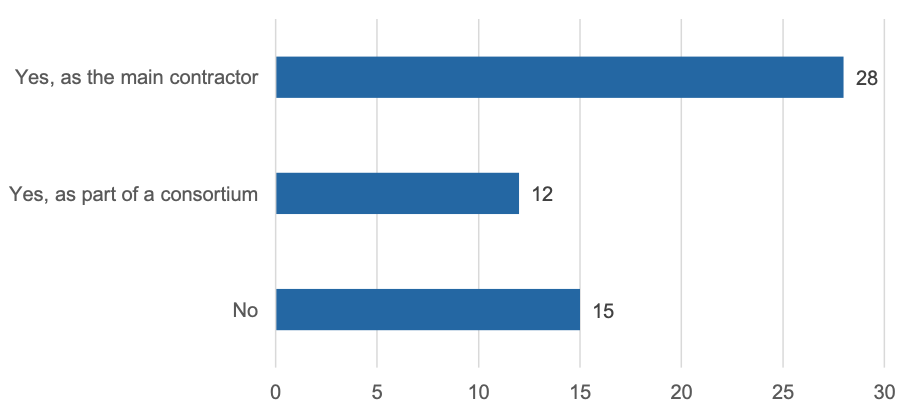
As indicated in the graph above, 28 (58%) respondents had bid as the main contractor, and 12 (25%) had bid as part of a consortium. Fifteen (31%) respondents to the survey had not bid for public sector contracts within the last five years and their insights were particularly useful in relation to identifying barriers to participation.
Figure 5 below shows the frequency with which survey respondents engage with Scottish public procurement. The graph excludes those respondents that have not bid for contracts within the last five years.
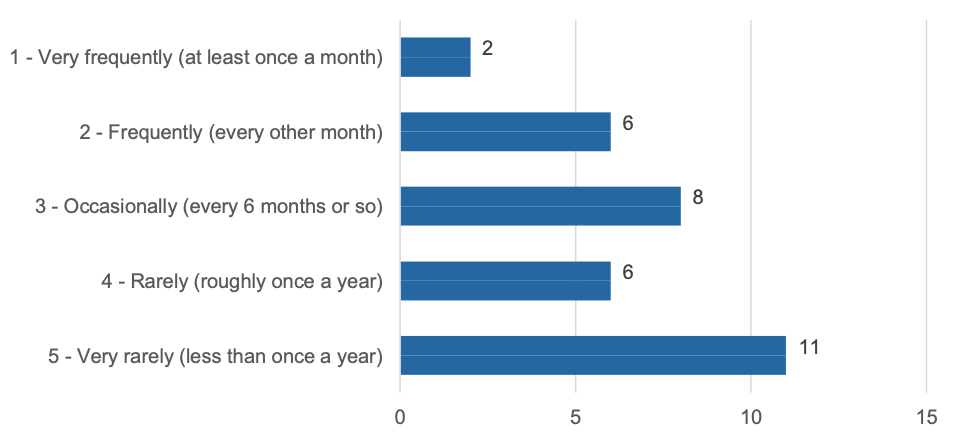
Figure 5 shows a mixed picture in relation to frequency of bidding for contracts. Eleven (33%) organisations bid very rarely (less than once a year), eight (24%) organisations bid occasionally (every six months or so), six organisations (18%) bid roughly once a year, and a further six (18%) bid frequently (described as every other month). Only two (6%) organisations reported bidding very frequently (at least once a month).
This accords with what interviewees told us. Some indicated that they bid frequently for contracts (as frequently as once a month), whereas others bid only occasionally or very rarely.
“We have bid once, but it took up so much time.” (New private business interviewee)
“We have bid on a number of occasions and we are working towards being 40% funded by public contracts, 40% funded by grants, and 20% funded by public donations.” (Third sector interviewee)
“We have bid a lot and we have been undertaking contracts and commissions for 10 years. We monitor opportunities all of the time.” (Third sector interviewee)
Which parts of the public sector do organisations contract with?
Survey respondents were asked which parts of the Scottish public sector their organisation has contracted with in the last five years. As can be seen in Figure 6, 28 (85%) survey respondents had contracted with local authorities, six (18%) had contracted with central government and six (18%) had contracted with the NHS. A smaller percentage had contracted with universities and colleges (9%, or three respondents) and registered social landlords (6%, or two respondents). “Other” organisations that respondent organisations had contracted with included schools. It is not surprising that the percentage of organisations contracting with local authorities was the highest, given that local government accounted for two thirds of procurement spend in Scotland in 2019/20.[14]
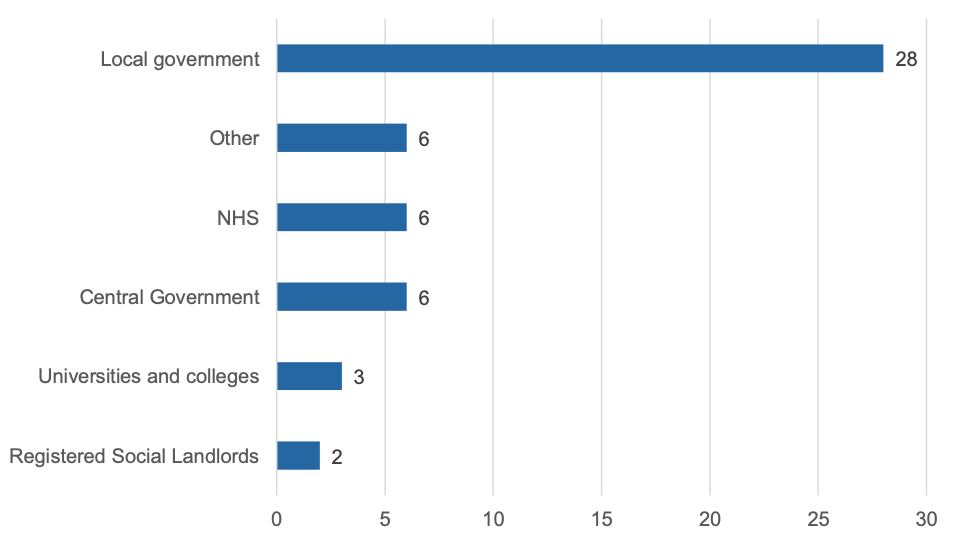
Among interviewees, the picture was less skewed towards local government, however most had contracted with either local government, the NHS or Scottish Government.
In some instances, organisations had bid previously to one part of the public sector but had then ceased to do so because of their low rate of success. For example, one small third sector organisation had submitted bids on their own and as part of a large consortium of organisations to their local authority but had consistently lost out to larger providers.
“We tried to bid but it was so complicated. It feels like the right language needs to be used.” (Third sector interviewee)
The NHS seems particularly geared towards larger providers.” (New private business interviewee)
This variation in levels and types of engagement has been valuable in giving us insight into organisations’ views of public procurement based on a range of different types of experiences.
Benefits of bidding and contracting
Through the research, we sought to explore why third sector organisations and new businesses contract with the public sector. Research participants were consistent in their feedback, with survey respondents and interviewees alike noting that security of contracts and reliability of payments were the greatest benefits of public contracts.
“We bid for contracts that align to our strategic aims, and contracts allow us the opportunity to secure income for multi-year programmes.” (Third sector interviewee)
In Figure 7 we provide a breakdown of the benefits of contracting with the public sector, as indicated by survey respondents:
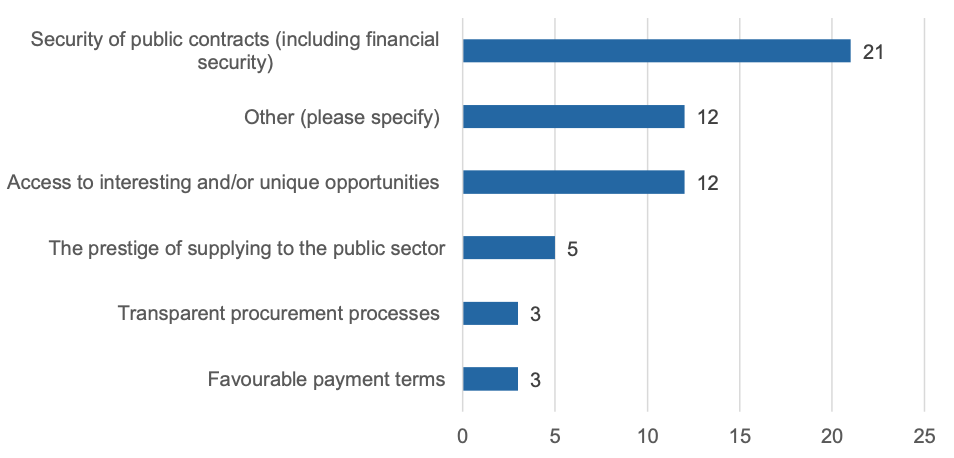
As can be seen above, security of public contracts was most frequently cited as a benefit of public contracts (21 respondents, or 64% of respondents, indicated this was a benefit). Twelve (36%) respondents also cited access to interesting and/or unique opportunities as a benefit. A smaller number indicated that the prestige of supplying to the public sector (five respondents, or 15%) and favourable payment terms (three respondents, or 9%) were among the benefits they had gained from bidding.
Some of the additional comments from survey respondents to this question included:
“It gives sustainability and unrestricted funding for the benefit of our organisation.” (Third sector survey respondent)
“Ultimately our purpose is to help people so getting funding enables this.” (Third sector survey respondent)
“It helped us to transform services from organisation-centred to person-centred.” (Third sector survey respondent)
These findings were backed up by interviewees from both the third sector and new private businesses who described the public sector as very reliable in relation to payments and stability of contracts. Some interviewees also observed that the potential for winning future contracts served to incentivise organisations to “do a good job”. In addition, some interviewees observed that relationships with the public sector tend to be less commercial and more collaborative (once procurement processes were complete).
A small number of other benefits were also cited by survey respondents and interviewees including:
- enabling the organisation to provide consistency of support to service users and build capacity in their relationships with and knowledge of local people
- improving communication and links to the public sector
- enabling provision to people who use their services
- enabling the organisation to be innovative in their approach to their work
- building the resilience of local supply chains
- reputational benefit.
Stakeholders also confirmed that reliability of payments was a key benefit for organisations in their sector.
"It is a good route for income/survival.” (Stakeholder)
“The public sector makes prompt payments. The public sector also ensures that the main contractors are paying sub-contractors. This is all good progress and it increases confidence in organisations.” (Stakeholder)
“The public sector is a good customer, they pay reliably.” (Stakeholder)
One stakeholder also pointed out the benefits of contracting with the public sector in relation to capacity building. The additional funding provided through winning public sector contracts enabled them to build skills and expand their workforce, creating additional capacity within their organisation for the future.
However, another stakeholder also noted the risk for some new private businesses that only contract with the public sector:
“Some are in a precarious situation where the public sector is their only contractor and could change supplier.” (Stakeholder)
A few interviewees also reported that contracting with the public sector was particularly important when there is an economic downturn and the private sector may be more reluctant to spend. This point was emphasised by some stakeholders too.
“The public sector gives me access to clients. The private sector is not always as willing to afford consultancy. It has been a game-changer for me. It’s worth the pain of tendering!” (New private business interviewee)
What new private businesses and third sector organisations can offer the public sector
In addition to exploring what the benefits of public sector contracting are to third sector organisations and new private businesses, we also asked interviewees about the benefits, for the public sector, of contracting with them, and about what they felt they could offer to the public sector.
Many cited local knowledge and expertise in particular. This was considered by many to be their unique and strongest selling point. A number highlighted the growing importance of this, particularly in the context of the community wealth building agenda and climate change targets.
“We are very well placed to help the public sector. We have a good reputation in schools. They miss a trick when they remove things from organisations like us. We bridge gaps to families for schools. We have local relationships – 18 families came to our meeting recently. They trust us because we are a local service.” (Third sector interviewee)
Views on the extent to which the Scottish public sector is willing and able to contract with the third sector and new private businesses
We asked survey respondents and third sector and new private business interviewees to reflect on the extent to which the Scottish public sector is willing and able to do business with third sector organisations and new private businesses.
Figure 8 shows the survey responses to this question, with 19 (58%) indicating that the public sector was willing and able “to some extent”, nine (27%) felt that it was willing and able “to a great extent”, and five (15%) felt that it was not at all able or willing.
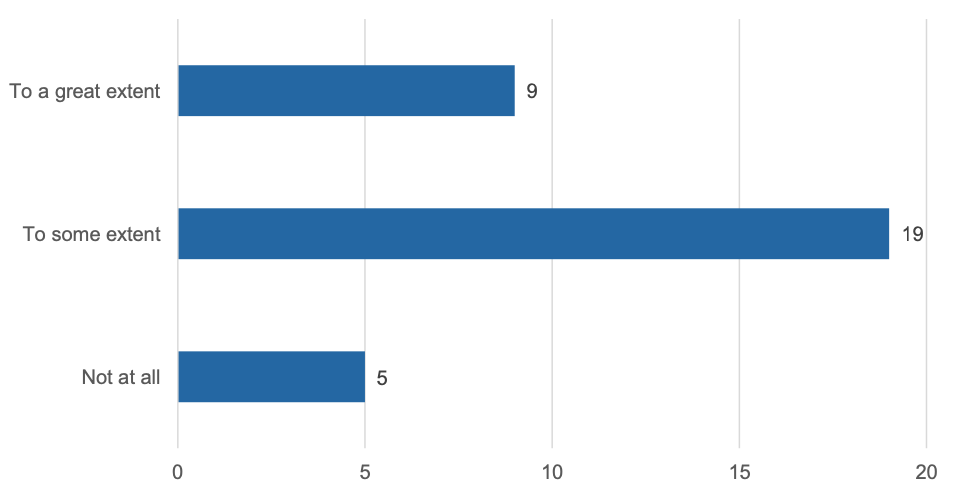
Supporting comments suggest that respondents’ perceptions are that public procurement was designed for large corporate organisations that have the manpower to develop and submit bids, and that the public sector does not see the third sector as having the capacity to deliver large contracts.
“They tend to go for national or multi-national organisations instead of smaller niche organisations.” (Third sector survey respondent)
“It is designed for big corporates and there is never anything [available] for East Lothian and Scottish Borders.” (Third sector survey respondent)
Interviewees responded very similarly. Some felt that while the public sector was, in theory, willing to do business with organisations like theirs, the reality was different. This was due to the same reasons highlighted by survey respondents – a lack of understanding of the burden of procurement processes on smaller organisations, and too little value placed on local knowledge and relationships.
A small number of organisations were more positive in their responses, commenting that:
“In general we feel respected and valued in our relationships with local officials – but do we really need to re-tender Health and Social Care?” (Third sector survey respondent)
“We have experience and credibility in successfully delivering contracts, however we are not a large national organisation.” (Third sector survey respondent)
Extent to which it is easy to bid for Scottish public sector contracts
Through our survey, we asked respondents to indicate the extent to which they found it easy to bid for Scottish public sector contracts. As can be seen in Figure 9, a combined 27 respondents (82% of respondents to this question) indicated that the process was difficult or very difficult. Only six (18%) described the process as easy or very easy.
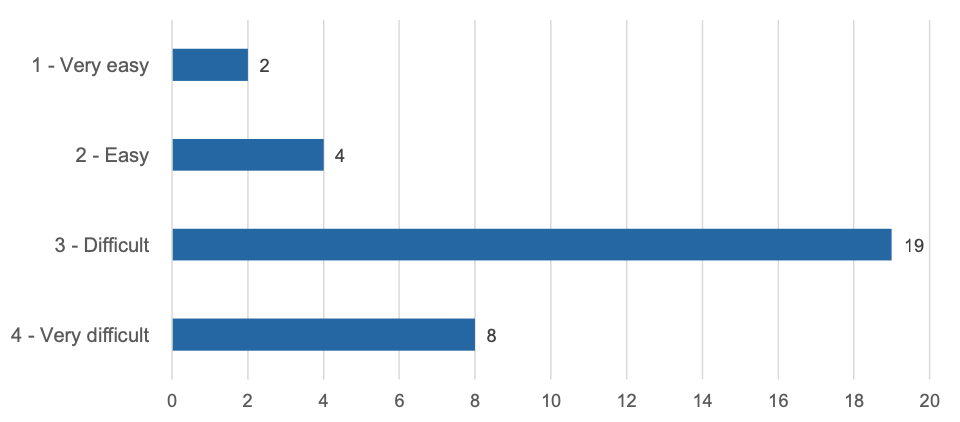
Of those who indicated that the process of bidding for Scottish public sector contracts was easy or very easy, one respondent described the process of application as “very easy and electronic” and another felt that there were clear processes to follow if you had resources available within your organisation. Another organisation referred to the ease of being sent tenders that may be of interest once you had registered on the procurement site (whilst noting that the process of bidding itself can be cumbersome).
In our survey, we also asked respondents what, if anything, has made it difficult for their organisation to bid for Scottish public sector contracts. As shown in Figure 10, the vast majority of respondents highlighted a lack of time/capacity to produce bids (25 respondents, or 81%), and the complexity of the bidding process (19, or 61%) as the two most significant challenges.
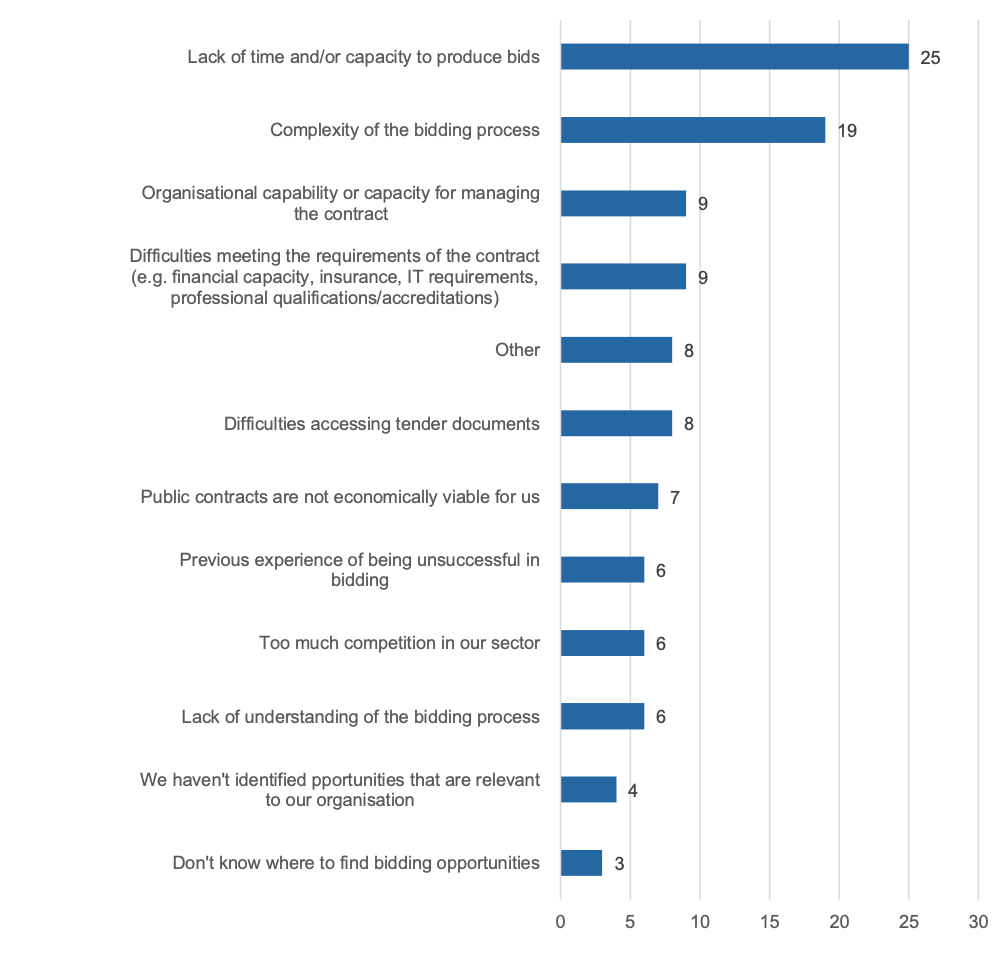
Survey respondents were asked to note any other issues that had made it difficult for their organisation to bid for public sector contracts and their comments included:
“Too many to mention – bids are designed for the organisation and not the bidder or recipient.” (Third sector survey respondent)
“Mismanaged processes by [the] tendering authority – [including] stalled/restart processes – [and the impact of this] on our resources.” (Third sector survey respondent)
“Contracts [are] not written in ways to suit person-centred services for citizens, carers and communities.” (Third sector survey respondent)
“[Our] managerial capacity to go through the procurement system especially as this was new to us.” (Third sector survey respondent)
These issues were mirrored throughout the in-depth discussions we had with representatives of third sector organisations and new private businesses. These are outlined further in Chapter 3.
Uptake of training and support
Training and support is an important component of the public procurement system in Scotland. This is currently provided through organisations and initiatives such as Just Enterprise and the Supplier Development Programme (SDP).
Just Enterprise, a consortium of third sector organisations, has been delivering Scottish Government-funded business support to the third sector since 2011. It offers targeted, tailored support to complement and enhance local advice services through one-to-one specialist support, workshops, webinars and resources via a network of delivery partners across Scotland. It provides procurement training tailored to the needs of the third sector and complements the support funded by the Scottish Government since 2016 to help enterprising third sector organisations to form new partnerships or consortia, strengthen existing collaborations, and ensure organisations build their capacity to better secure contracts or funding.
Previously known as Partnership for Procurement (P4P), Scottish Government support for partnering for procurement will continue to be provided through future iterations of the business support contract, providing a ‘one-stop shop’ for third sector organisations seeking specialist procurement support.
The SDP was established in 2008 and provides free tendering advice and assistance with contract management, and holds national and local Meet the Buyer events for Scottish SMEs and third sector organisations.
The results of our survey (shown in Figure 11) indicate that take-up of current support provision among those who had recently bid for a public contract is reasonably good. This ties in with the findings from our discussions with new private businesses and third sector organisations and with stakeholders.
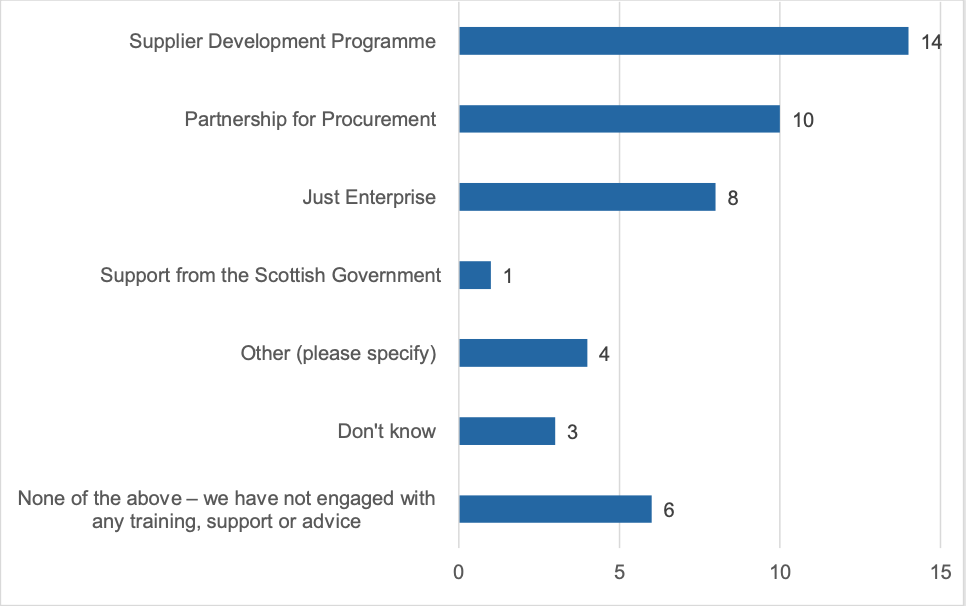
As the graph above indicates, 14 (47%) of respondents who had recently bid for a public contract had engaged with the SDP, 10 (33%) had engaged with P4P and eight (27%) had engaged with Just Enterprise at some stage in the last five years. Those respondents indicating through our survey that they had accessed support from other sources noted that they had received support from Third Sector Interfaces, Community Enterprise in Scotland (CEiS), and private advisors that they paid for themselves.
In addition, through our survey we asked a number of questions that were directed at organisations that do not currently bid for public sector contracts. As Figure 12 below shows, among these, nine organisations (69%) had not engaged with any training, support or advice in the last five years, but three (23%) indicated that they had engaged with Just Enterprise, two (15%) with P4P and two (15%) with SDP.
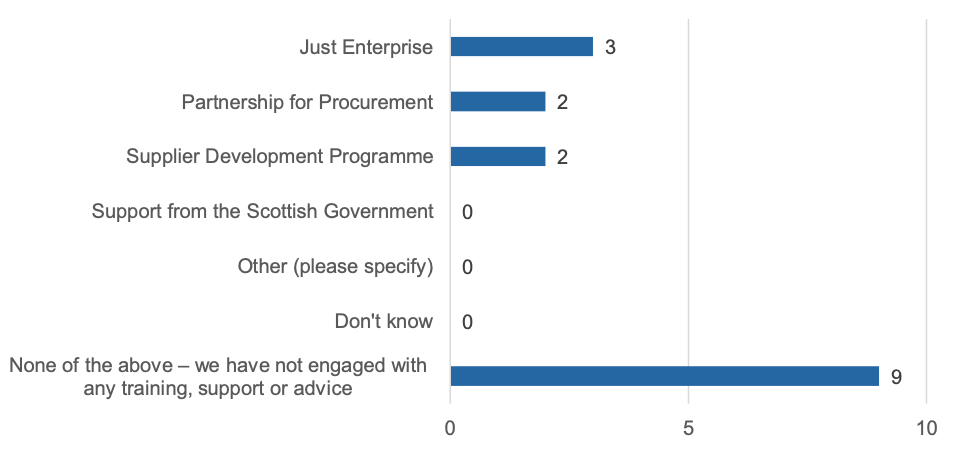
When comparing the results outlined in Figures 11 and 12, the data suggests that there is a positive correlation between engaging with training and support on one hand and engaging with the procurement process itself by bidding for contracts on the other. We return to the issue – and value – of training and support in Chapter 4 in more detail.
Experiences of Quick Quotes processes
One of the ways in which the public sector has sought to make public procurement processes more streamlined is through the introduction of the Quick Quote process, through which a limited number of organisations are invited to tender for a contract. The contract must be below a set value (for goods and services, £50,000 excluding VAT) to qualify for a Quick Quote process[17] [18].
We explored with survey respondents and interviewees the extent to which they had experience of Quick Quote processes, and how effective they found these. Among the responses from organisations that had recently bid for a public contract, Figures 13 and 14 show the proportion of survey respondents that had been invited to tender through a Quick Quote process, and how this experience compared to any open tender processes they had participated in.
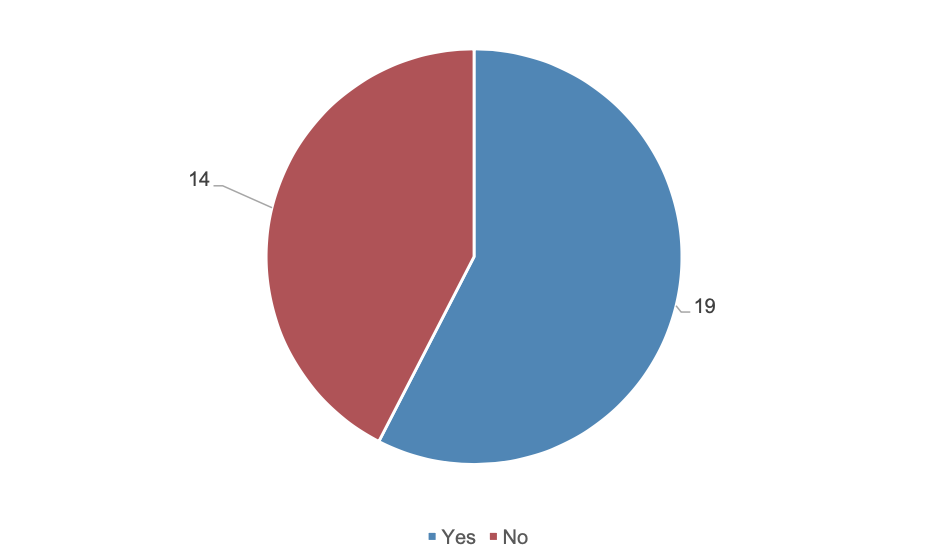
As Figure 13 shows, the majority of bidding organisations (19, or 57%) had experience of the Quick Quote process.
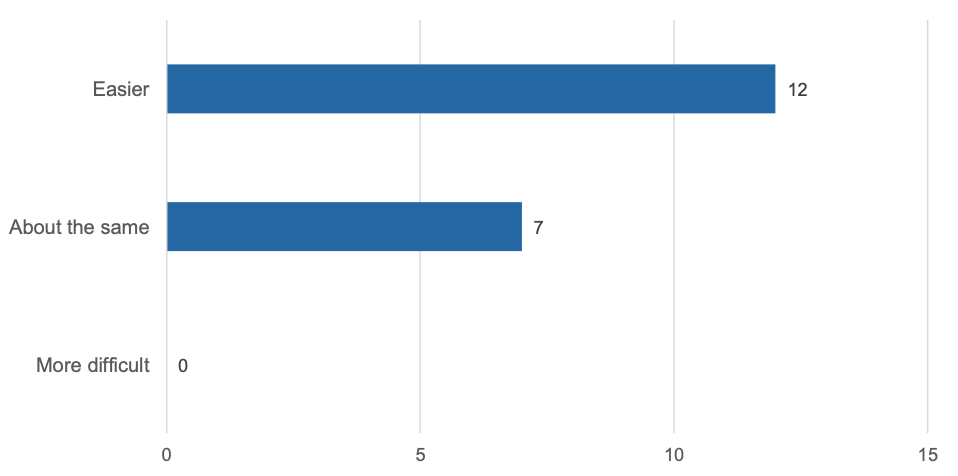
As shown in Figure 14, survey respondents with experience of Quick Quote processes had found the Quick Quote process easier than the open tender processes they had been involved in. Twelve respondents (63%) had found the Quick Quote process easier, and seven (37%) organisations had found the process about the same as the open tender process.
The qualitative feedback gathered on the Quick Quote process through the survey and interviews was less clear. Very few interviewees had been involved in Quick Quote processes. Of those who had experience of Quick Quotes, most found the process easier, but a number indicated that it had not improved their levels of success in winning contracts. Similarly, as one survey respondent noted:
“Quick quotes are not necessarily easier. Tender processes are too rigid.” (Third sector survey respondent)
We return to the issue of Quick Quotes later in this report.
Reasons for not bidding for public contracts
We also explored the reasons why some organisations had not bid to the Scottish public sector in recent years. Figure 15 shows the reasons why respondents to our survey indicated that they had not bid recently:
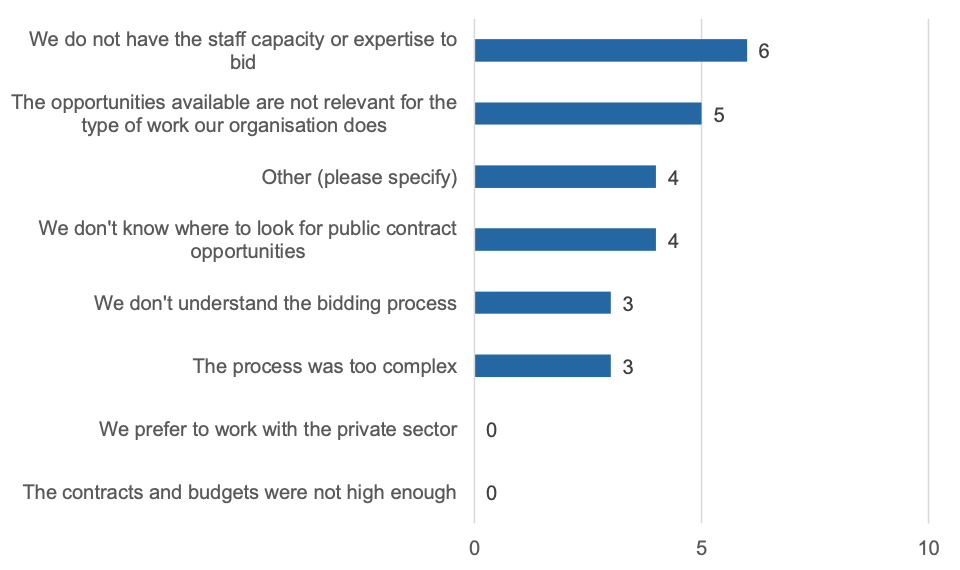
As Figure 15 shows, survey respondents gave a variety of reasons for not bidding for public sector contracts. The highest proportion of respondents (six, or 40%) indicated that they did not have the staff capacity or expertise to bid, with a similar proportion (five, or 33%) indicating that the opportunities were not relevant for the type of work they undertake. Four respondents (27%) said they did not bid because their organisation did not know where to look for public contract opportunities.
Other reasons given for not bidding included one organisation already having a service level agreement in place with their local authority, and another had an ongoing contract with their local authority.
In our survey, we then asked organisations that had indicated they had not bid for public contracts in the last five years whether they would consider doing so in future. As Figure 16 shows, 80% of respondents to this question (or 12 respondents) indicated that they would consider doing so in future. This clear appetite to engage suggests that there is the potential for Scottish Government and the wider public sector to tap into a greater supplier base than it does currently.
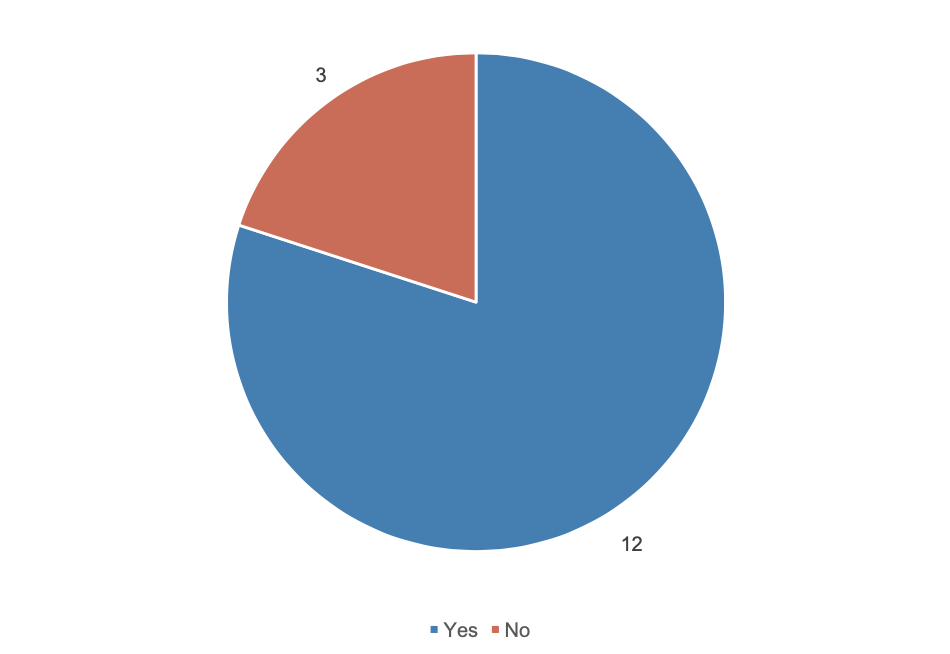
Those who indicated they would not consider doing so in future indicated that they either did not have the capacity to expand outwith their current area, or that it was not applicable to them.
We explore these challenges and barriers to participation in Scottish public procurement in further depth in the next chapter.
Contact
Email: scottishprocurement@gov.scot
There is a problem
Thanks for your feedback